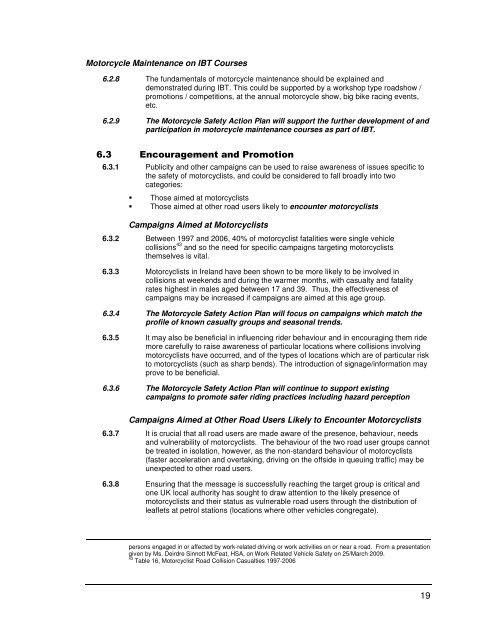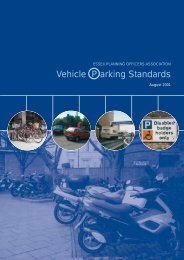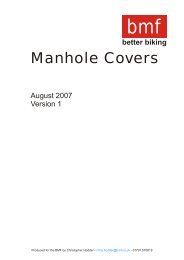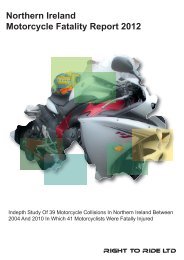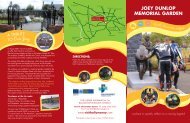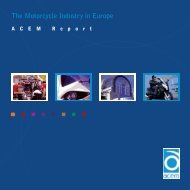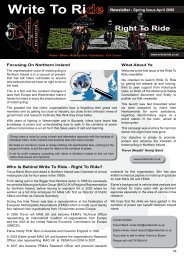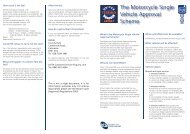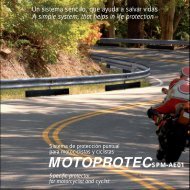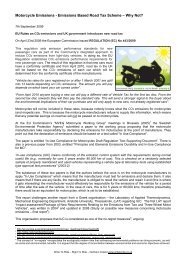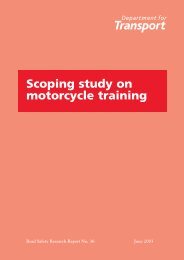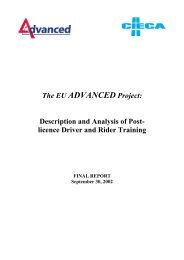national motorcycle safety action plan 2010 – 2014 - Right To Ride
national motorcycle safety action plan 2010 – 2014 - Right To Ride
national motorcycle safety action plan 2010 – 2014 - Right To Ride
You also want an ePaper? Increase the reach of your titles
YUMPU automatically turns print PDFs into web optimized ePapers that Google loves.
Motorcycle Maintenance on IBT Courses<br />
6.2.8 The fundamentals of <strong>motorcycle</strong> maintenance should be explained and<br />
demonstrated during IBT. This could be supported by a workshop type roadshow /<br />
promotions / competitions, at the annual <strong>motorcycle</strong> show, big bike racing events,<br />
etc.<br />
6.2.9 The Motorcycle Safety Action Plan will support the further development of and<br />
participation in <strong>motorcycle</strong> maintenance courses as part of IBT.<br />
6.3 Encouragement and Promotion<br />
6.3.1 Publicity and other campaigns can be used to raise awareness of issues specific to<br />
the <strong>safety</strong> of motorcyclists, and could be considered to fall broadly into two<br />
categories:<br />
<br />
<br />
Those aimed at motorcyclists<br />
Those aimed at other road users likely to encounter motorcyclists<br />
Campaigns Aimed at Motorcyclists<br />
6.3.2 Between 1997 and 2006, 40% of motorcyclist fatalities were single vehicle<br />
collisions 43 and so the need for specific campaigns targeting motorcyclists<br />
themselves is vital.<br />
6.3.3 Motorcyclists in Ireland have been shown to be more likely to be involved in<br />
collisions at weekends and during the warmer months, with casualty and fatality<br />
rates highest in males aged between 17 and 39. Thus, the effectiveness of<br />
campaigns may be increased if campaigns are aimed at this age group.<br />
6.3.4 The Motorcycle Safety Action Plan will focus on campaigns which match the<br />
profile of known casualty groups and seasonal trends.<br />
6.3.5 It may also be beneficial in influencing rider behaviour and in encouraging them ride<br />
more carefully to raise awareness of particular locations where collisions involving<br />
motorcyclists have occurred, and of the types of locations which are of particular risk<br />
to motorcyclists (such as sharp bends). The introduction of signage/information may<br />
prove to be beneficial.<br />
6.3.6 The Motorcycle Safety Action Plan will continue to support existing<br />
campaigns to promote safer riding practices including hazard perception<br />
Campaigns Aimed at Other Road Users Likely to Encounter Motorcyclists<br />
6.3.7 It is crucial that all road users are made aware of the presence, behaviour, needs<br />
and vulnerability of motorcyclists. The behaviour of the two road user groups cannot<br />
be treated in isolation, however, as the non-standard behaviour of motorcyclists<br />
(faster acceleration and overtaking, driving on the offside in queuing traffic) may be<br />
unexpected to other road users.<br />
6.3.8 Ensuring that the message is successfully reaching the target group is critical and<br />
one UK local authority has sought to draw attention to the likely presence of<br />
motorcyclists and their status as vulnerable road users through the distribution of<br />
leaflets at petrol stations (locations where other vehicles congregate).<br />
persons engaged in or affected by work-related driving or work activities on or near a road. From a presentation<br />
given by Ms. Deirdre Sinnott McFeat, HSA, on Work Related Vehicle Safety on 25/March 2009.<br />
43 Table 16, Motorcyclist Road Collision Casualties 1997-2006<br />
19


